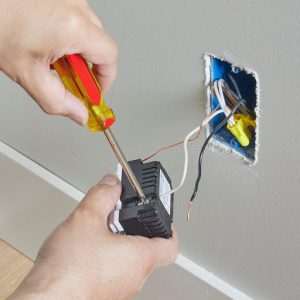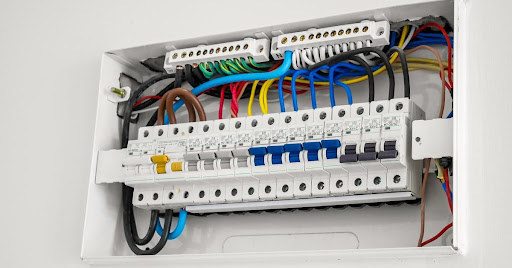Wiring Types Codes – What Are They and What Can You Do to Identify Them?

Thanks to the 18th edition of BS 7671 (meaning British Standard, or the Regs), your electrical wires’ colour has changed.
These revisions are common as standards are updated for greater safety and consistency throughout the UK.
This simple guide will cover information on identifying the common wiring and cables you may encounter.
Wire Colour Coding Explained
It’s important to know the correct colours before installing any electrical system. Earth wires are green, while the live and neutral wires are brown and blue.
Properly labelled electrical wiring will make electric power distribution smoother and ensure that every electrical cable in a building functions properly. This holds whether your job site is a home or office.
These colours typically won’t show you the voltage or size of the wire but are useful for showing its form or purpose.
Check the wiring regulations for more info on the 18th edition colour codes.
What Classifies as a DIY Project?
Before you begin laying a new cable through your wall, it’s advised to check whether your proposed project requires a professional electrician’s input.
Generally, cable maintenance and altering existing installations can be done by a homeowner, but follow caution.
However, laying new circuits or replacing a fuse box will require a competent person’s aid. If you’re training to become a professional electrician, prepare properly with an 18th-edition mock exam.
Different Wiring Types – Current Colours
18th edition is the newest electrical wiring standard, and it dictates that any new buildings must have wiring installed up to code.
This update to BS 7671 became mandatory in 2006 to create a common colour code between the UK and the EU, back when the UK was a member of the EU.
However, this only applies to new wiring and cable work. For example, any wiring from before 2006 commonly follows the old colour coding scheme.
However, any new wiring work must follow the updated colour code.
NOTE: You may be unable to determine whether you’re dealing with a live or neutral cable. It’s best practise to assume they’re all dangerous, saving you from touching a wire without proper insulation.
Earth – Green With a Yellow Stripe
Currently, earth (sometimes called ground) cables are coloured bright green with a yellow stripe. This wire provides a safe path to ground for any power flowing through it.
The earth wire is included for safety purposes. They’re also typically bare because they carry a small amount of voltage, so leaving them uninsulated is safe.
Earth wiring is vital because it diverts any electricity to a safe place, often an underground metal plate, without the risk of shocking the next person who touches a wire or appliance.
Live – Brown
Live connections are brown and carry the most powerful wires we’ve discussed. Exercise caution when handling this type of wire, as it can cause an electric shock.
Live wiring has different forms of insulation depending on the voltage of the wiring, but this can wear out over time.
Assume any exposed wiring is live regardless of colour or type, and handle it cautiously.
Neutral – Blue
The neutral cable is a bright blue and carries similar power to the earth cable. The voltage difference between these wires should ideally be within 1 volt to 1.5 volts.
If you’ve found a difference larger than 1.5 volts, we recommend finding the source of the difference.
Despite having almost equal power as the earth wire, you should still exercise caution while handling a blue wire to avoid shocking yourself.
Old Colours
Here is the old colour coding scheme for electrical wiring.
- Earth – Green and Yellow
- Live – Red
- Neutral – Black
As you can see, the colour of the earth or ground cable hasn’t changed. Both the current and old colour coding schemes are used for three-phase electrical systems.
Australian and US Colour Codes
For example, we’ve included this section in case you look at the wiring that doesn’t match the new 18th edition colour codes.
Australian Wire Colours
Some parts of Australia follow the UK and EU standard for cable colouring, thanks to changes laid out in AS3000 in 2018.
Australian wiring mostly follows the UK standard, but it’s common to encounter installations that follow an outdated colour coding scheme.
Some live wires in Australia are white instead of brown. White is unique to Australia.
Current Colour Scheme
- Earth – Green and Yellow
- Live – Brown
- Neutral – Blue
Old Colour Scheme
- Earth – Green
- Live – Red
- Neutral – Black
US Wire Colours
The colour scheme for wiring and cables in the US denotes low and high-voltage wires, making the scheme a useful tool for determining voltage.
A white cable denotes a low-voltage neutral wire, as dictated by the NEC (National Electric Code.)
High-Voltage
- Earth – Green
- Live – Brown
- Neutral – Grey
Low-Voltage
- Earth – Green
- Live – Black
- Neutral – White
Different Types of Wiring
Here we’ll identify some of the different types of wires that you’ll typically find.
Being able to sort wires by type is useful and will always be applicable regardless of wire brand or manufacturer.
- Three-Core – This cabling will have 3 insulated cores and a PVC sheath.
- Twin and Earth – This is the common cabling for homes with blue and brown insulation.
How Else Can You Identify Wiring?
Apart from the colour, the most reliable way to identify a cable is through its markings or any labels it may have.
Carefully inspect the wiring around the job site for letters or printed labels. If you can see the brand or manufacturer, check their products for a better idea.
Mains Fuse Box

After all the electrical wiring in a home has been installed, it’s important to know where the mains fuse box is in case you need to revisit a worksite.
The service panel should represent all electrical connections, including the main switch, RCDs, and circuit breakers.
- Main Switch – This switch will bypass all cables and let you turn off all the power to your home.
- RCD (Residual Current Devices) – These devices will trigger if it senses power flowing unintended through circuits, protecting homeowners from injury.
- Circuit Breakers – Similar to RCDs, a breaker will disrupt any circuits in case of an electrical fault.
Frequently Asked Questions (FAQs)
Check this section for more information on electrical cable installation.
Is 18th Edition Certification Training Mandatory?
Before you proceed with electrical network installation, we recommend undergoing 18th edition training to follow the BS 7671 standard.
This training isn’t mandatory, but undergoing it is vital for reference and will help you work on modern installations without issue. It will also help electricians self-certify their work.
It should be noted that BS 7671 is the bare minimum standard and should be exceeded instead of complied with.
What Is a Conduit?
An electrical conduit is a tube or pipe designed to protect wires running through them. Conduits are useful if running a long wire towards an outdoor installation like a shed.
All conduits have a maximum wire capacity which depends on a few factors. These include the conduit’s construction material and size.
For example, an aluminium conduit has a different fill capacity than a non-metallic conduit.
What’s the Difference Between Cables and Wires?
A wire and cable may seem the same, but they have a major difference. A wire is one conductor, while a cable is a group of conductors.
Both wiring and cables are typically protected by insulation made from PVC or rubber.
Conclusion
It’s helpful to revisit the basics before you begin a cable installation job, whether you’ve turned your home into a DIY project or on the job.
There’s a lot more to learn about wires and cable work, but learning how the power flows through your home is always useful.
If your installation has a number of different cables and circuits, remember to include easy-to-access information on clearly-printed labels for future maintenance work.